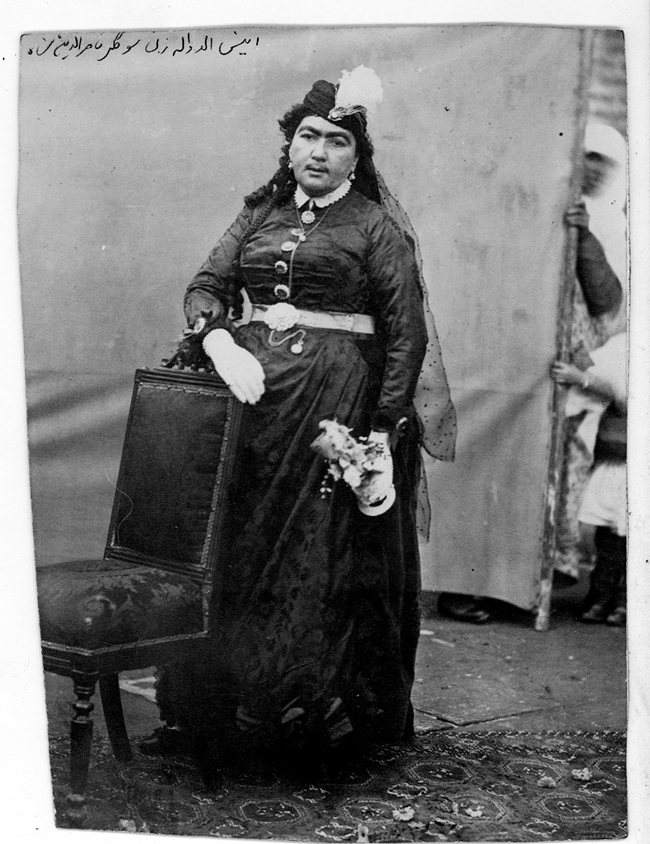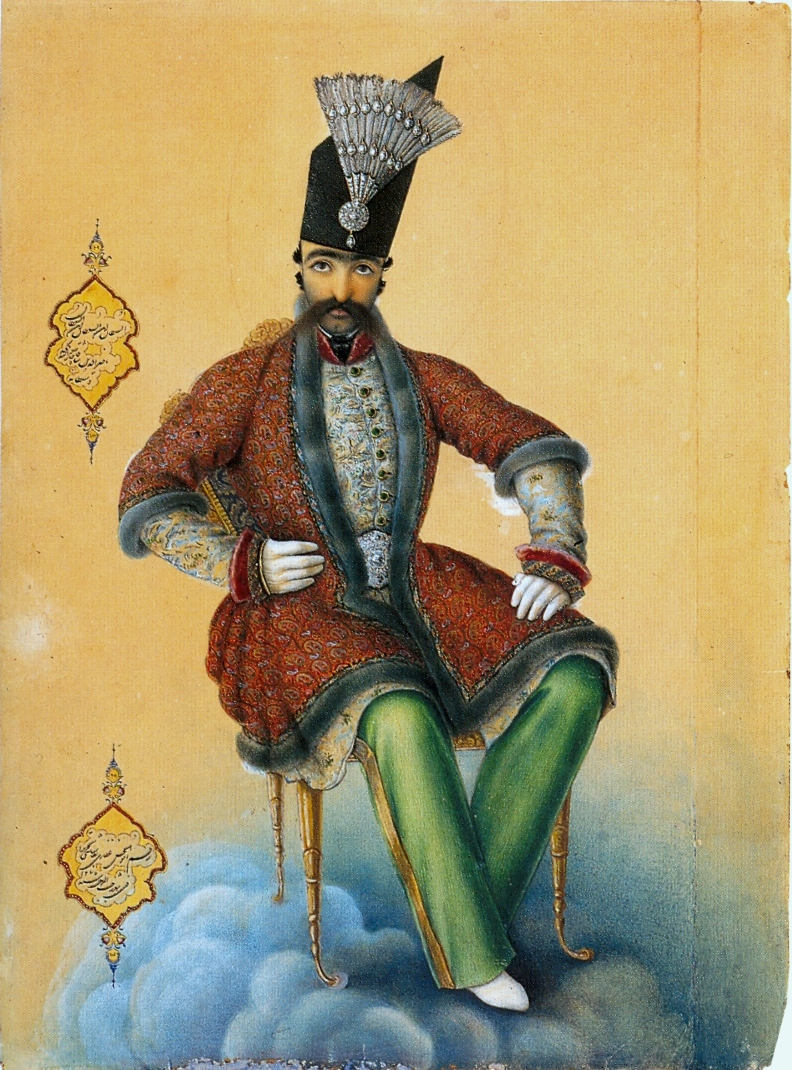|
Anīs-al-dawla
file:ملیجک_و_انیسالدوله.jpg, link=https://fa.wikipedia.org/wiki/%D9%BE%D8%B1%D9%88%D9%86%D8%AF%D9%87:%D9%85%D9%84%DB%8C%D8%AC%DA%A9_%D9%88_%D8%A7%D9%86%DB%8C%D8%B3%E2%80%8C%D8%A7%D9%84%D8%AF%D9%88%D9%84%D9%87.jpg, 232x232px, Anis al-Dawla and Aziz al-Soltan Anis al-Dawla (died 1896) was a royal consort of shah Naser al-Din Shah Qajar of Persia (r. 1848–1896).G. Nashat, “ANĪS-AL-DAWLA,” Encyclopædia Iranica, II/1, pp. 74-76, available online at http://www.iranicaonline.org/articles/anis-al-dawla-d (accessed on 30 December 2012). Life She was the daughter of an impoverished shepherd in a from a village in Lavāsān, northeast of Tehran, and was employed as a free maidservant to Jeyran (wife of Naser al-Din Shah) in the Qajar harem in 1859. She became the favorite of the shah after Jeyrān's death in 1860. She was the only wife to take meals with Nāṣer-al-dīn and to join him regularly at bedtime after he received visits from other wives; she was also t ... [...More Info...] [...Related Items...] OR: [Wikipedia] [Google] [Baidu] |
Amina Aqdas
Amina Aqdas (died 1893) was a royal consort of shah Naser al-Din Shah Qajar of Persia (r. 1848–1896).G. Nashat,Amīna Aqdas" Encyclopædia Iranica, I/9, pp. 954-955, accessed on 30 December 2012. She was the daughter of an impoverished shepherd in a from a village near Garrūs in Kurdistan, and was employed as a free maidservant to the shah's wife Anīs-al-dawla in the Qajar harem in 1859. She eventually became a favorite of the shah, second only to Anīs-al-dawla. Contemporaries attributed her influence to an ability to manipulate of the shah's weak spots: she catered to his whims, encouraged his obsessions, and appealed to his parsimony. Her power was also enhanced by the shah's intense attachment to her nephew, Gholam-Ali, Malijak-e Thani, also known as Aziz Al-Soltan. She supported the career of Mirza Ali Asghar Khan Amin al-Soltan Mirza Ali Asghar Khan ( fa, میرزا علیاصغر خان; 6 January 1858 – 31 August 1907), also known by his honorific titles of ... [...More Info...] [...Related Items...] OR: [Wikipedia] [Google] [Baidu] |
Naser Al-Din Shah Qajar
Naser al-Din Shah Qajar ( fa, ناصرالدینشاه قاجار; 16 July 1831 – 1 May 1896) was the fourth Shah of Qajar Iran from 5 September 1848 to 1 May 1896 when he was assassinated. He was the son of Mohammad Shah Qajar and Malek Jahan Khanom and the third longest reigning monarch in Iranian history after Shapur II of the Sassanid dynasty and Tahmasp I of the Safavid dynasty. Nasser al-Din Shah had sovereign power for close to 51 years. He was the first modern Persian monarch who formally visited Europe and wrote of his travels in his memoirs. A modernist, he allowed the establishment of newspapers in the country and made use of modern forms of technology such as telegraphs, photography and also planned concessions for railways and irrigation works. Despite his modernizing reforms on education, his tax reforms were abused by people in power, and the government was viewed as corrupt and unable to protect commoners from abuse by the upper class which led to increasi ... [...More Info...] [...Related Items...] OR: [Wikipedia] [Google] [Baidu] |
Jeyran (wife Of Naser Al-Din Shah)
Jeyran (; born Khadijeh Khanum Tajrishi (), 1831–1860) was one of the beloved wives and first mistress of Naser al-Din Shah Qajar (1848-1896). Known for her beauty and charm, Jeyran was born as Khadijeh, daughter of Mohammad Ali, a gardener and carpenter. She met Naser al-Din Shah circa 1850 and married him in 1851. She was given title of ''Forough al-Saltanah''. Jeyran spread her influence by the birth of her second child, Mohammad Qasem Mirza and who was made commander-in-chief. Although he had no maternal Qajar ancestor, with a fake lineage made for Jeyran which linked her to Sasanids and Ilkhanate, he became crown prince, but shortly got sick and died. Afterwards, Jeyran lost all of her children and got tuberculosis. She died in 1860. Her death had an impact on Naser al-Din Shah, who abandoned the royal responsibilities for a while. Early life Jeyran was born in 1831 in Tajrish village near Tehran. Named "Khadijeh", she was the daughter of Mohammad Ali, a gardener an ... [...More Info...] [...Related Items...] OR: [Wikipedia] [Google] [Baidu] |
Qajar Harem
The harem of the monarchs of the Qajar dynasty (1785-1925) consisted of several thousand people. The harem had a precise internal administration, based on the women's rank. Hierarchy and organisation Mother of the Shah As was customary in Muslim harems, the highest rank of the harem hierarchy was that of the monarchs' mother, who in Qajar Iran had the title ''Mahd-e ʿOlyā'' (Sublime Cradle). She had many duties and prerogatives, such as safeguarding the harem valuables, particularly the jewels, which she administered with the help of female secretaries. Consorts In contrast to what was common in the Ottoman Empire, where the sultans normally only had slave consorts, the Qajar shah's also had a custom of diplomatic marriages with free Muslim women, daughters of Qajar dignitaries and princes. Another phenomena of the Qajar harem was that the Shah entered two different kinds of marriages with his harem women: '' ṣīḡa'' (temporary wife), which was often done with concubines, a ... [...More Info...] [...Related Items...] OR: [Wikipedia] [Google] [Baidu] |
Mirza Hosein Khan Moshir Od-Dowleh
Mirza Hosein Khan Moshir od-Dowleh Sepahsalar ( fa, میرزا حسین خان مشیرالدوله سپهسالار) or simply Mirza Hosein Sepahsalar ( fa, میرزا حسین سپهسالار) (1828–1881) was the Grand Vizier (prime minister) of Iran (Persia) during the Qajar dynasty under King Naser al-Din Shah Qajar between 1871 and 1873. After a successful career in the Iranian foreign service, serving in Tiflis, Mirza Hosein Khan was made ambassador to Istanbul during the great Ottoman reform period after 1856. He seems also to have been influenced by at least two reformist thinkers: Fatali Akhundov, whom he got to know well in Tiflis, and Mirza Malkam Khan, whom he met in Istanbul. On becoming Grand vizier, Mirza Hosein persuaded the Shah to grant a concession for railroad construction—the Reuter concession—and other commercial development projects to Baron de Reuter. Opposition from bureaucratic factions and clerical leaders, however, forced the Shah to dismiss hi ... [...More Info...] [...Related Items...] OR: [Wikipedia] [Google] [Baidu] |
Malek Jahan Khanom
Malek Jahan Khanom ( fa, ملک جهان خانم; 26 February 1805 – 2 April 1873) was the wife of Mohammad Shah Qajar of Persia and the mother of Naser al-Din Shah. She was the ''de facto'' regent of Persian Empire for one month, from 5 September until 5 October in 1848, between the death of her husband and the accession to the throne of her son. Life Early life Malek Jahan Khanom was a Persian princess of the Qajar dynasty by both birth and marriage. By birth, being the daughter of Amir Mohammad Qassem Khan Qajar Qovanlou 'Amir Kabir' and Princess Begom Jan Khanom Qajar, she was the granddaughter of Fath-Ali Shah Qajar of Persia. Her paternal grandfather was the powerful Qajar commander Amir Soleyman Khan Qajar Qovanlou 'Amir Kabir' 'Nezam od-Doleh' 'Etezad od-Doleh' and her paternal grandmother was a princess of the Zand dynasty. Marriage She was married at a young age to her cousin, Mohammad Shah Qajar of Persia (reign 1834–1848). Her husband married about ... [...More Info...] [...Related Items...] OR: [Wikipedia] [Google] [Baidu] |
1896 Deaths
Events January–March * January 2 – The Jameson Raid comes to an end, as Jameson surrenders to the Boers. * January 4 – Utah is admitted as the 45th U.S. state. * January 5 – An Austrian newspaper reports that Wilhelm Röntgen has discovered a type of radiation (later known as X-rays). * January 6 – Cecil Rhodes is forced to resign as Prime Minister of the Cape of Good Hope, for his involvement in the Jameson Raid. * January 7 – American culinary expert Fannie Farmer publishes her first cookbook. * January 12 – H. L. Smith takes the first X-ray photograph. * January 17 – Fourth Anglo-Ashanti War: British redcoats enter the Ashanti capital, Kumasi, and Asantehene Agyeman Prempeh I is deposed. * January 18 – The X-ray machine is exhibited for the first time. * January 28 – Walter Arnold, of East Peckham, Kent, England, is fined 1 shilling for speeding at (exceeding the contemporary speed limit of , the first sp ... [...More Info...] [...Related Items...] OR: [Wikipedia] [Google] [Baidu] |
Qajar Royal Consorts
Qajar Iran (), also referred to as Qajar Persia, the Qajar Empire, '. Sublime State of Persia, officially the Sublime State of Iran ( fa, دولت علیّه ایران ') and also known then as the Guarded Domains of Iran ( fa, ممالک محروسه ایران '), was an Iranian state ruled by the Qajar dynasty, which was of Turkic origin,Cyrus Ghani. ''Iran and the Rise of the Reza Shah: From Qajar Collapse to Pahlavi Power'', I. B. Tauris, 2000, , p. 1William Bayne Fisher. ''Cambridge History of Iran'', Cambridge University Press, 1993, p. 344, Dr Parviz Kambin, ''A History of the Iranian Plateau: Rise and Fall of an Empire'', Universe, 2011, p.36online edition specifically from the Qajar tribe, from 1789 to 1925.Abbas Amanat, ''The Pivot of the Universe: Nasir Al-Din Shah Qajar and the Iranian Monarchy, 1831–1896'', I. B. Tauris, pp 2–3; "In the 126 years between the fall of the Safavid state in 1722 and the accession of Nasir al-Din Shah, the Qajars evolved from a s ... [...More Info...] [...Related Items...] OR: [Wikipedia] [Google] [Baidu] |





.jpg)